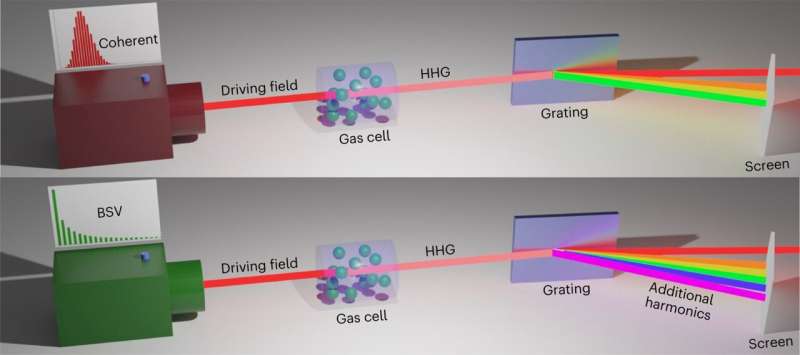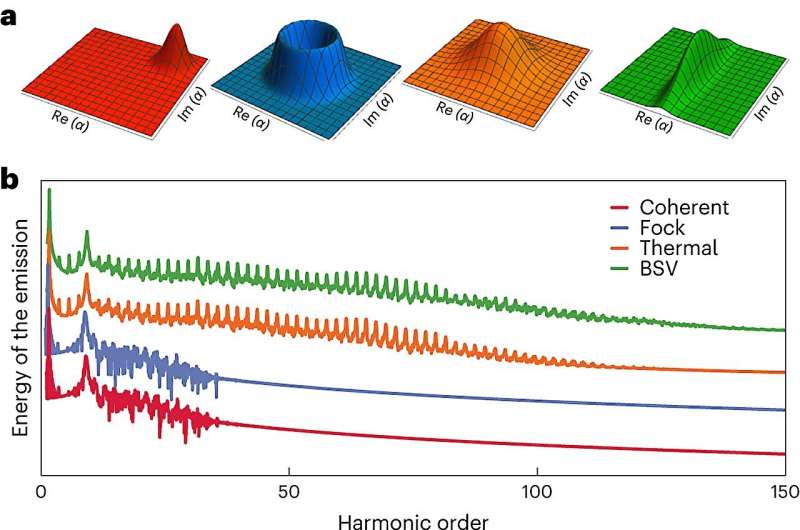September 5, 2023 feature
This article has been reviewed according to Science X's editorial process and policies. Editors have highlighted the following attributes while ensuring the content's credibility:
fact-checked
peer-reviewed publication
trusted source
proofread
A theory of strong-field non-perturbative physics driven by quantum light

Non-perturbative interactions (i.e., interactions too strong to be described by so-called perturbation theory) between light and matter have been the topic of numerous research studies. Yet the role that quantum properties of light play in these interactions and the phenomena arising from them have so far remained widely unexplored.
Researchers at Technion–Israel Institute of Technology recently introduced a new theory describing the physics underpinning non-perturbative interactions driven by quantum light. Their theory, introduced in Nature Physics, could guide future experiments probing strong-field physics phenomena, as well as the development of new quantum technology.
This recent paper was the result of a close collaboration between three different research groups at Technion, led by principal investigators Prof. Ido Kaminer, Prof. Oren Cohen and Prof. Michael Krueger. Students Alexey Gorlach and Matan Even Tsur, co-first authors of the paper, spearheaded the study, with support and ideas from Michael Birk and Nick Rivera.
"This was a major scientific journey for us," Prof. Kaminer and Gorlach told Phys.org. "We began thinking about high harmonic generation (HHG) and its quantum features already in 2019. Back then, the light in all HHG experiments was explained classically and we wanted to find when quantum physics starts to play role there.
"Frankly, it bothered us that several foundational phenomena in physics were each explained by a completely different theory, thus it was not possible to relate them. For example, HHG was based on a theory that contradicted the theory usually applied to calculate spontaneous emission—each explained on a different basis."
HHG is a highly nonlinear physical processes that entails a strong interaction between light and matter. Specifically, it occurs when intense pulses of light applied to matter cause it to emit so-called high-harmonics of the driving intense light pulse.
For a few years, Prof. Kaminer and his research group have been trying to devise a single quantum theory-based framework that would collectively account for all photonics phenomena, including HHG. Their first paper on this topic, published in Nature Communications in 2020, introduced a proposed version of this unifying framework, analyzing HHG in the language of quantum optics.
"This study contributed to opening the now-rising field of quantum HHG," Prof. Kaminer and Gorlach explained. "Still, all HHG experiments were driven by classical laser fields. It even seemed like there cannot be any quantum light intense enough to create HHG. However, works by Prof. Maria Chekhova showed that it is possible to create intense enough quantum light in a form known as bright squeezed vacuum. This motivated our new investigation."

As part of their new study, Prof. Kaminer, Gorlach and their colleagues devised a full framework describing strong-field physics processes driven by quantum light. To theoretically validate their framework, they applied it to HHG, predicting how this process would change if driven by quantum light.
"We showed that on the contrary to expectations, many important features like the intensity and spectrum, all change as a result of using a driving light source with different quantum photon statistics," Prof. Kaminer and Gorlach said. "The paper we wrote also predicts experimentally feasible scenarios that cannot be explained in any other means except by considering the photon statistics. These upcoming experiments will be of even greater impact and importance to this rising field of strong-field quantum optics."
So far, the work carried out by this team of researchers is purely theoretical. Their paper introduces the very first theory of non-perturbative processes driven by quantum light, while also theoretically demonstrating that the quantum state of light affects measurable quantities, such as the emitted spectrum.
"The way our theory works is by splitting the driving light into one of two representations called the generalized Glauber distribution or the Husimi distribution, and then using the conventional simulations of the HHG field, the time-dependent Schrodinger equation (TDSE), to simulate separately the parts of the distribution, before combining the simulations together to derive the overall result," Prof. Kaminer and Gorlach said.
"This connection of the standard tools of the community into such a quantum-optical calculation scheme is what made our work powerful and useful—applicable to an arbitrary quantum state of light and an arbitrary system of emitters."
The new theory derived by Prof. Kaminer, Gorlach and their colleagues could soon inform studies in different areas of physics. In fact, their paper envisions taking the idea beyond HHG, to a wide range of non-perturbative processes, which can all be driven by non-classical light sources.
This theoretical prediction could soon be tested and validated in experimental settings. For instance, the team's theory can be directly applied to the generation of attosecond pulses via HHG, a process that can underpin the functioning of quantum sensing and quantum imaging technologies.
In that regard, the team published a recent theory paper in Nature Photonics that proposed controlling the attosecond pulse profiles using the quantum nature of light, for example showing promising conditions using a mixture of classical light and quantum squeezed light.
In addition, their theory could be applied to other phenomena based on strong-field physics, such as the Compton effect, a process used to generate X-ray pulses.
"We recently published a follow-up paper on this application in Science Advances, which ended up appearing earlier due to delays in the peer-review process," Kaminer and Gorlach added about the Compton effect. "We are now working toward performing the experiment theoretically discussed in our paper.
"Another ambitious goal will be to generalize the developed theory beyond HHG, and to investigate quantum effects in various materials driven by intense light, which connects our new developments in quantum optics to the frontiers of condensed matter physics."
More information: Alexey Gorlach et al, High-harmonic generation driven by quantum light, Nature Physics (2023). DOI: 10.1038/s41567-023-02127-y
Matan Even Tzur et al, Photon-statistics force in ultrafast electron dynamics, Nature Photonics (2023). DOI: 10.1038/s41566-023-01209-w
Majed Khalaf et al, Compton scattering driven by intense quantum light, Science Advances (2023). DOI: 10.1126/sciadv.ade0932
Journal information: Science Advances , Nature Communications , Nature Photonics , Nature Physics
© 2023 Science X Network





















